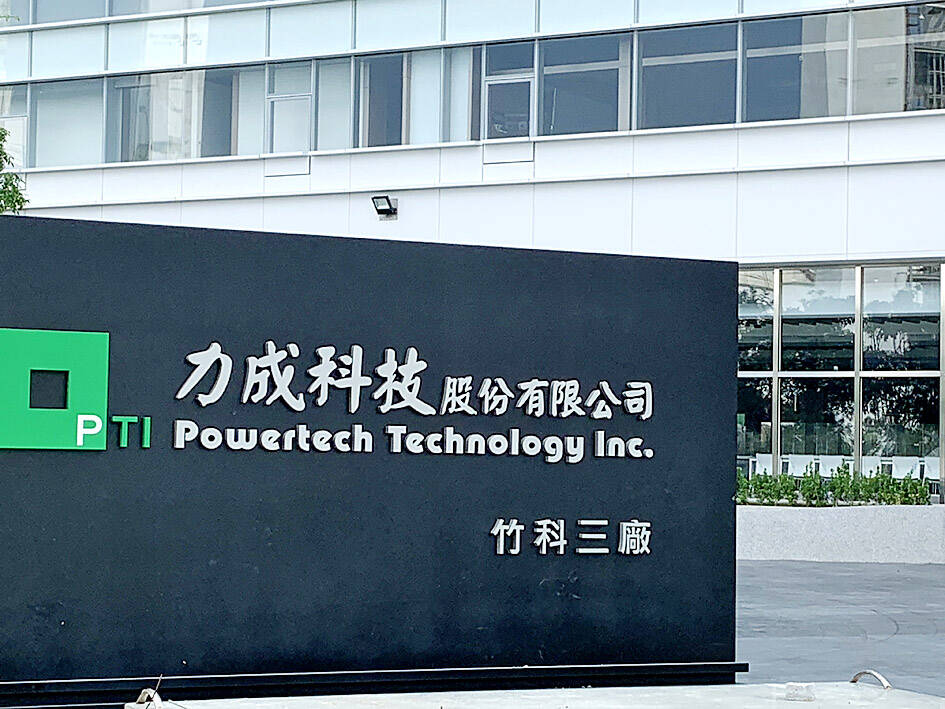Chip testing and packaging service provider Powertech Technology Inc (PTI, 力成科技) plans to increase this year’s capital expenditure by 50 percent to expand capacity to meet growing demand for advanced memorychips used in artificial intelligence (AI) products.
The company proposed to spend NT$15 billion (US$460.94 million) to expand advanced capacity and equipment, compared with a budget of NT$10 billion it planned three months ago.
“We are seeing a recovery in market demand as well as new business opportunities. We will spend heavily on advanced packaging” equipment, Powertech chief executive officer Boris Hsieh (謝永達) told investors on Tuesday. “We will focus on ramping up advanced technologies we have developed in the past few years. We believe PTI will begin to harvest its investments in advanced technologies this year.”

Photo: Grace Hung, Taipei Times
A major portion of the capital budget would be spent on advanced, or 2.5D, packaging technologies used in AI and high-performance computing (HPC) chips, including through-silicon vias technology for high-bandwidth memorychips and advanced testing technology, the company said.
The investment would also be used to boost advanced flip chip ball grid array technology packaging capacity for higher-density and faster advanced DRAM DDR5 chips, which are used in edge AI devices such as smartphones and computers with AI capabilities, it said.
The Hsinchu-based memorychip packager expects a gradual increase in revenue contribution from advanced packaging and testing technologies for high-bandwidth memorychips from the final quarter of this year, given equipment supply constraints.
In the near term, PTI expects revenue this quarter to grow a mid-to-high single-digit percentage this quarter from NT$18.33 billion last quarter, thanks to a pickup in chips used in consumer application chips from the current quarter, Hsieh said.
“As demand for PCs, smartphones and consumer products gradually increases in the second quarter, revenue will grow compared with the first quarter,” Hsieh said. “Besides, data center and HPC application demand is driving an increase in DDR5 DRAM.”
NAND flash memorychip packaging and testing revenue is expected to grow by a double-digit percentage sequentially this quarter due to rising demand for solid-state drive storage for data centers, he said.
“We are optimistic that AI-related applications will gradually emerge in the second half,” he said.
The company expects chip packaging equipment utilization to rise to about 75 percent this quarter from 70 percent, while testing equipment use is to increase to 55 percent from 50 percent.
DRAM packaging and testing services accounted for 24 percent of the company’s total revenue last quarter, while NAND flash memorychips made up 28 percent. Logic packaging and testing services accounted for 37 percent.
PTI on Tuesday reported annual growth of 54 percent in net profit for last quarter, totaling NT$1.74 billion, compared with NT$1.13 billion in the first quarter of last year.
On a quarterly basis, it declined 56 percent from NT$3.97 billion, including an asset disposal gain of NT$2.6 billion.
Earnings per share rose to NT$2.32 last quarter from NT$1.51 in the same period last year, but plummeted NT$5.31 in the previous quarter.

When an apartment comes up for rent in Germany’s big cities, hundreds of prospective tenants often queue down the street to view it, but the acute shortage of affordable housing is getting scant attention ahead of today’s snap general election. “Housing is one of the main problems for people, but nobody talks about it, nobody takes it seriously,” said Andreas Ibel, president of Build Europe, an association representing housing developers. Migration and the sluggish economy top the list of voters’ concerns, but analysts say housing policy fails to break through as returns on investment take time to register, making the

NOT TO WORRY: Some people are concerned funds might continue moving out of the country, but the central bank said financial account outflows are not unusual in Taiwan Taiwan’s outbound investments hit a new high last year due to investments made by contract chipmaker Taiwan Semiconductor Manufacturing Co (TSMC, 台積電) and other major manufacturers to boost global expansion, the central bank said on Thursday. The net increase in outbound investments last year reached a record US$21.05 billion, while the net increase in outbound investments by Taiwanese residents reached a record US$31.98 billion, central bank data showed. Chen Fei-wen (陳斐紋), deputy director of the central bank’s Department of Economic Research, said the increase was largely due to TSMC’s efforts to expand production in the US and Japan. Investments by Vanguard International

WARNING SHOT: The US president has threatened to impose 25 percent tariffs on all imported vehicles, and similar or higher duties on pharmaceuticals and semiconductors US President Donald Trump on Wednesday suggested that a trade deal with China was “possible” — a key target in the US leader’s tariffs policy. The US in 2020 had already agreed to “a great trade deal with China” and a new deal was “possible,” Trump said. Trump said he expected Chinese President Xi Jinping (習近平) to visit the US, without giving a timeline for his trip. Trump also said that he was talking to China about TikTok, as the US seeks to broker a sale of the popular app owned by Chinese firm ByteDance Ltd (字節跳動). Trump last week said that he had

STRUGGLING TO SURVIVE: The group is proposing a consortium of investors, with Tesla as the largest backer, and possibly a minority investment by Hon Hai Precision Nissan Motor Co shares jumped after the Financial Times reported that a high-level Japanese group has drawn up plans to seek investment from Elon Musk’s Tesla Inc to aid the struggling automaker. The group believes the electric vehicle (EV) maker is interested in acquiring Nissan’s plants in the US, the newspaper reported, citing people it did not identify. The proposal envisions a consortium of investors, with Tesla as the largest backer, but also includes the possibility of a minority investment by Hon Hai Precision Industry Co (鴻海精密) to prevent a full takeover by the Apple supplier, the report said. The group is